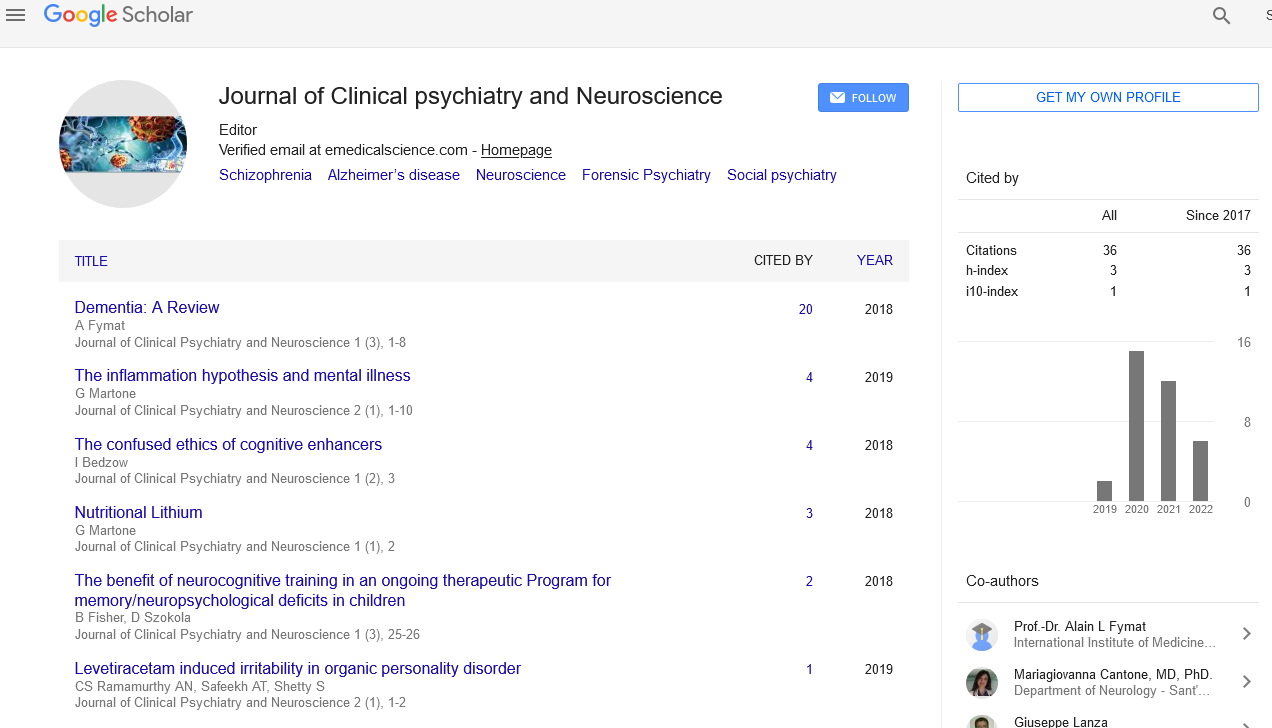Treatments for Obsessive-Compulsive Disorder in TBI Patients
Received: 06-Nov-2022, Manuscript No. PULJCPN-23-6128; Editor assigned: 08-Nov-2022, Pre QC No. PULJCPN-23-6128 (PQ); Accepted Date: Nov 25, 2022; Reviewed: 20-Nov-2022 QC No. PULJCPN-23-6128 (Q); Revised: 22-Nov-2022, Manuscript No. PULJCPN-23-6128 (R); Published: 27-Nov-2022, DOI: 10.37532/puljcpn.2022.5(6).66-7
Citation: Ve M. Treatments for obsessive-compulsive disorder in TBI patients. J Clin Psychiatry Neurosci.2022; 5(6):66-7.
This open-access article is distributed under the terms of the Creative Commons Attribution Non-Commercial License (CC BY-NC) (http://creativecommons.org/licenses/by-nc/4.0/), which permits reuse, distribution and reproduction of the article, provided that the original work is properly cited and the reuse is restricted to noncommercial purposes. For commercial reuse, contact reprints@pulsus.com
Abstract
A Traumatic Brain Injury (TBI) can result from an item piercing the skull and entering the brain, as well as from a strong bump, blow, or jolt to the head or body. A TBI is not always the consequence of strikes or jolts to the head.
Depending on the kind of TBI, there may be temporary or short-term issues with a person's ability to think, understand, move, communicate, and act. Serious and lasting disabilities, as well as death, can result from more severe TBI.
Key Words
Neurochemical Pathways
Introduction
TBI occurs when an external force (or forces) causes damage to the brain. The incidence of TBI in Australia has not been determined definitively; however, best estimates range from 100400/100,000. TBI pathophysiology is multifactorial, but the end result is disrupted neuro circuitry, which causes dysfunction. It can cause anything from a minor physiological disruption to widespread axonal tearing. Secondary processes like hypoxia, intracranial hypertension, fat embolism, subarachnoid hemorrhage, and oxidative free radical production can exacerbate the initial insult. The most common aetiological factors are Motor Vehicle Accidents (MVAs), falls, physical assaults, and sports-related injuries.
Obsessive-Compulsive Disorder (OCD) is a long-term condition marked by obsessions and/or compulsions. Obsessions are unwanted and intrusive thoughts, urges, or impulses that increase anxiety, whereas compulsions are repeated behaviors or acts that reduce anxiety. OCD is recognized as one of the most common and debilitating psychiatric disorders. OCD pathophysiology and aetiology are complex and multifactorial, with multiple neuroanatomical, neurophysiological, and neurochemical pathways involved.
There is a growing body of evidence that OCD exists in TBI patients. Following a TBI, the onset of OCD can range from days to years. Following a TBI, the prevalence of OCD ranges between 2%-15%.
TBI-related neurological and neuropsychiatric complications can have a significant impact on the rehabilitation process. Long-term functional independence is difficult to achieve, and as a result, Quality Of Life suffers (QOL). Many patients require extensive multidisciplinary rehabilitation, putting a significant strain on the community's public health and economic resources.
Inpatient medical rehabilitation teams may seek advice from the Consultation- Liaison Psychiatry service on the diagnosis and treatment of OCD in TBI patients. The diagnosis of OCD in TBI patients is particularly difficult. TBI can cause a combination of primary physical, cognitive, behavioural, and affective impairments, making it difficult to diagnose and treat secondary comorbidities like OCD. Neuropsychological studies on non-TBI OCD patients have revealed that OCD can cause deficits in executive control, attention, and memory.
It is unclear whether guidelines exist for managing OCD in TBI; however, guidelines for managing OCD in the general population are well established. The guidelines almost always recommend a combination of pharmacotherapy and psychotherapy. Firstline pharmacotherapy typically includes Selective Serotonin Reuptake Inhibitors (SSRIs) or clomipramine, and psychotherapeutic measures frequently include Cognitive Behavioural Therapy (CBT).
However, certain factors must be considered before beginning OCD treatment in patients with TBI. TBI patients have increased neuronal sensitivity to pharmacological agents, decreased neuropsychological capacity for psychological therapy, and a higher prevalence of concurrent medical comorbidities. Clinically useful recommendations or guidelines for managing OCD in TBI patients would be helpful.
To treat OCD in the TBI population, pharmacological, psychological, combination treatments, and ECT have been used. There is no highquality evidence to support firm recommendations; however, it is worth noting that treatments not explicitly mentioned in guidelines for treating OCD in the general population appear to have had some success in treating OCD in a TBI population. This review of the literature reveals a scarcity of high-quality research, and that additional research in this area would support recommendations for future clinical practice.
Only descriptive case reports and case series were used as evidence. There were only a few studies with mixed data and no RCTs. This review was originally intended to be systematic; however, due to the scarcity of research and the poor quality of available evidence, a narrative approach was adopted.
The majority of cases did not use a standardized assessment tool to quantify the effect of treatment, instead relying on subjective clinical response. Because of the use of different outcome measures, direct comparisons between cases were difficult.
One study did not specify the exact medication used (e.g., 'tricyclic antidepressant,' and others did not provide information on the doses and frequency of medication or therapy. The majority of studies made no mention of side effects.
Due to physical and cognitive impairments, as well as diagnostic masking, the diagnosis of OCD in TBI would be complicated. Perseverations can manifest similarly to compulsions. In many cases, it was unclear how the author(s) arrived at the diagnosis of OCD.
For the purposes of this review, efficacy was determined when the case reported some benefit from treatment. It is possible that some articles were overlooked due to inconsistent indexing in electronic databases. Biases (for example, observer bias and publication bias) could have influenced the author's findings and conclusions.





